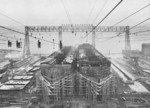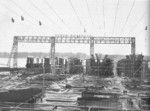Deutsche Werft Hamburg
| Type | 213 Shipyard | |
| Historical Name of Location | Hamburg, Germany | |
| Coordinates | 53.538061000, 9.865033000 |
Contributor: Al Griffis
ww2dbaseIn 1916, a new shipyard named Hamburger Werft AG was established in the Finkenwerder section of Hamburg, Germany. Shipping magnate Albert Ballin, the leading figure of the new shipyard, used his influence with Kaiser Wilhelm II for Hamburger Werft to build merchant ships to replace shipping lost during the war thus far, and he promised short build times and reasonable prices. Major investors of the shipyard included Gutehoffnungshütte (GHH), Allgemeine Elektricitäts-Gesellschaft (AEG), and Hamburg Amerikanische Packetfahrt Actien Gesellschaft (HAPAG). The lease of the land was signed by AEG for the duration of 20 years. In 1917, work began on the construction of six slips. For various reasons, time being the most pressing, the slip foundations were given only a wood-pile base which limited the weight that each slip could hold to only 4,000 tons. In addition to the six slips a double horizontal slip was built mainly for construction of floating dry docks. Almost immediately the choice of Vorland I to build on became apparent. The narrowness of land precluded the building of satisfactory building halls near the slips, and the width of Kohlfleet channel, which is between the peninsula and Waltershof, precluded the placement of the floating dry dock, which was a necessity. Four of the six slips were completed during 1918. In Jun 1918, the shipyard was renamed Deutsche Werke AG. In the early years of the shipyard, it struggled for survival due to the lack of qualified workers, most of whom were in the service already, energy restrictions, and monumental material shortages. Much of the work completed between 1918 and 1920 were direct and indirect military business, although HAPAG did placed orders for 12 ships. In Nov 1918, Ballin committed suicide in response to the abdication of Wilhelm II. In 1919, the shipyard closed during the summer for three weeks due to lack of business. Around the same time, plans were drawn up and approved for a new shipyard further to the west, which had much more room, for another six slips of greater size. During the month of Jul 1919, deliveries of 150 to 200 tons of building materials arrived daily. Up until this time the Finkelwerder peninsula was a solid mass of land. Dredging work started on two channels to break Finkelwerder into three sections, Vorland I, II, and III, with the original 1917 shipyard located on the eastern-most Vorland I. The work on four of the slips on Vorland II began in Aug 1919, this time concrete was used as the foundation. There were to be three sets of two slips per section and each section was 50 meters in width and 182 meters in length. It was planned that ships exceeding 18,000 deadweight tonnage would be built on these slips. Additionally, the cable crane system would be used instead of the standard ground based cranes. 24 cables, 4 per slip, were used. Each cable was 280 meters in length and each slip was supported by cranes (cats as they were known) hanging from the four cables. Each cat could support 4 tons and up to 10 cats could be supported for a 40-ton lift if needed. Concurrently, the shipbuilding halls, warehouses and other support facilities were started as well. Meanwhile, the shipyard also received orders to build two 4.2K floating dry docks; they were launched in Dec 1919 and were completed in 1920. In 1920, work started on the dredging and widening channel A to a depth of 20 meters and a width of 40 meters. Special attention was paid to the construction of the equipping pier with the concrete being reinforced. Houses were built for the workforce and civil servants. A total of 146 houses were eventually built. By Jun 1920, all six slips on Vorland II were completed. The first orders to be laid down on the new slips were four Dutch motor tankers. From this point on all new orders were built on these slips. The slips on Vorland I were used for small ships and this section of the shipyard was used for repair work. The workforce grew quickly during this period. In Nov 1918, the shipyard had employed 300 men. This grew to 1,000 by the start of 1919 and to 6,000 by the end of 1921. In Jun 1923, the shipyard was renamed AEG-Deutsche Werft AG. In 1927, the company acquired Reiherstieg Werft, a Hamburg shipyard dating back to 1706 and had built three submarines during WW1, to bolster repair work business. In 1928, the company was reorganized to streamline work and purchased new machines and tools to increase performance. In 1928, the Reiherstieg shipyard added a new 100-meter dry dock, increased slips by three, and increased floating dry docks by five. In 1935, space was given to build additional repair shops, build additional warehouses, and increase pre-assembly space, all at the cost of a dry dock, which was filled in. During WW2, beginning in 1943, Vorland II was modified to add submarine bunkers and a horizontal launching area for construction of submarine sections. Between 1943 and 1944, the shipyard built 113 Type IX and Type XXIII submarines for the war effort. After the war, in 1968, the shipyard became a part of Howaldtswerke-Deutsche Werft (HDW). The former Deutsche Werft shipyard closed in 1985.
Last Major Update: Aug 2020
Ships Constructed at Deutsche Werft Hamburg
| Ship Name | Yard No | Slip/Drydock No | Ordered | Laid Down | Launched | Commissioned |
| C (Planned) | ||||||
| G (Planned) | ||||||
| H (Planned) | ||||||
| Havelland | 18 Aug 1939 | |||||
| U-2321 | I | |||||
| U-2322 | I | |||||
| U-2323 | II | |||||
| U-2324 | IV | |||||
| U-2325 | IV | |||||
| U-2326 | IV | |||||
| Schwabenland | 14 Mar 1925 | 16 Jul 1925 | ||||
| Erwin Wassner | 29 Jan 1938 | 11 Jan 1939 | ||||
| Thor | 214 | I | 16 Mar 1938 | 6 May 1938 | ||
| G | 21 Jun 1939 | 21 Jun 1939 | ||||
| M251 | 285 | 19 Sep 1939 | 12 Jan 1940 | 12 Jul 1940 | 16 Dec 1940 | |
| M252 | 286 | 19 Sep 1939 | 28 Mar 1940 | 27 Sep 1940 | 15 Feb 1941 | |
| M253 | 287 | 19 Sep 1939 | 1 Apr 1940 | 23 Nov 1940 | 21 Apr 1941 | |
| U-505 | 295 | 12 Jun 1940 | 24 May 1941 | 26 Aug 1941 | ||
| M254 | 288 | 19 Sep 1939 | 1 Jul 1940 | 17 Feb 1941 | 16 Jul 1941 | |
| M255 | 289 | 19 Sep 1939 | 1 Aug 1940 | 1 Apr 1941 | 11 Oct 1941 | |
| M256 | 290 | 19 Sep 1939 | 20 Mar 1941 | 31 May 1941 | 19 Jan 1942 | |
| U-1233 | 396 | 14 Oct 1941 | 29 Apr 1943 | 23 Dec 1943 | 22 Mar 1944 | |
| U-1234 | 397 | 14 Oct 1941 | 11 May 1943 | 7 Jan 1944 | 19 Apr 1944 | |
| U-1239 | II | 2 Apr 1942 | 20 Jul 1943 | |||
| U-1240 | II | 2 Apr 1942 | 21 Aug 1943 |
* Projected dates; not actual
Deutsche Werft Hamburg Interactive Map
Photographs
 |  |  |
Maps
 |
Deutsche Werft Hamburg Timeline
| 16 Aug 1916 | Hamburger Werft AG was established in Hamburg, Germany. Some documents indicated the founding date to be 25 Aug 1916 instead. |
| 6 Jun 1918 | Hamburger Werft AG in Hamburg, Germany was renamed Deutsche Werke AG. |
| 24 Dec 1919 | Deutsche Werke AG in Hamburg, Germany launched two 4.2K floating dry docks. |
| 24 Apr 1923 | The name AEG-Deutsche Werft AG was officially entered in the Commercial Register of Berlin-Mitte in Germany. |
| 9 Jun 1923 | Deutsche Werke AG in Hamburg, Germany was renamed AEG-Deutsche Werft AG. |
| 12 Jun 1940 | German Type IXC U-Boat U-505 was laid down at Deutsche Werft in Hamburg, Germany. |
| 25 May 1941 | German Type IXC U-Boat U-505 was launched down at Deutsche Werft in Hamburg, Germany. |
| 29 Apr 1943 | The keel of U-1233 was laid down at the Deutsche Werft yard in Hamburg, Germany. |
| 11 May 1943 | The keel for U-1234 was laid down at Deutsche Werft Hamburg, Germany. |
| 23 Dec 1943 | U-1233 was launched at the Deutsche Werft yard in Hamburg, Germany. |
| 7 Jan 1944 | U-1234 was launched at Deutsche Werft Hamburg, Germany. |
Did you enjoy this article or find this article helpful? If so, please consider supporting us on Patreon. Even $1 per month will go a long way! Thank you. Share this article with your friends: Stay updated with WW2DB: |
Visitor Submitted Comments
All visitor submitted comments are opinions of those making the submissions and do not reflect views of WW2DB.
| WW2-Era Place Name | Hamburg, Germany |
| Lat/Long | 53.5381, 9.8650 |
- » 1,150 biographies
- » 337 events
- » 43,917 timeline entries
- » 1,241 ships
- » 350 aircraft models
- » 207 vehicle models
- » 375 weapon models
- » 123 historical documents
- » 260 facilities
- » 470 book reviews
- » 28,545 photos
- » 432 maps
Thomas Dodd, late 1945
Please consider supporting us on Patreon. Even $1 a month will go a long way. Thank you!
Or, please support us by purchasing some WW2DB merchandise at TeeSpring, Thank you!
31 Aug 2022 06:52:40 AM
Hello,
I am interested in using the diagrams of the ship THEDOOR HERZL no/ 697 from year 1957, which was built for the ZIM company, as a reference to build a scale model of this ship. I would appreciate it if you could please share the diagram files with me through the email written above.
Thanks in advance,
Shaul Kremer